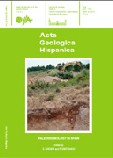Paleoliquefaction in the Bajo Segura basin (eastern Betic Cordillera)
Abstract
The Bajo Segura basin, in the eastern Betic Cordillera, displays a seismic activity characterized by small-magnitude earthquakes (1.5-4.5 mb), with some occasional moderate to high-magnitude events (> 5.0 mb). These earthquakes are produced by the activity of blind faults without surface ruptures. For this reason, the detection of paleoearthquakes in the geological record is limited to indirect evidence of paleoseismicity, mainly liquefaction features. Moreover, such evidence is abundant in the historical record of the 1829 Torrevieja earthquake, in some of its aftershocks and in the 1919 Jacarilla earthquake. In this study several layers of Holocene seismites previously described in the basin were analyzed, and correlated with various radiometric 14C datings. This analysis enabled a recurrence period of approx. 1000 yr to be established for the moderate to high-magnitude earthquakes in the Bajo Segura basin.


